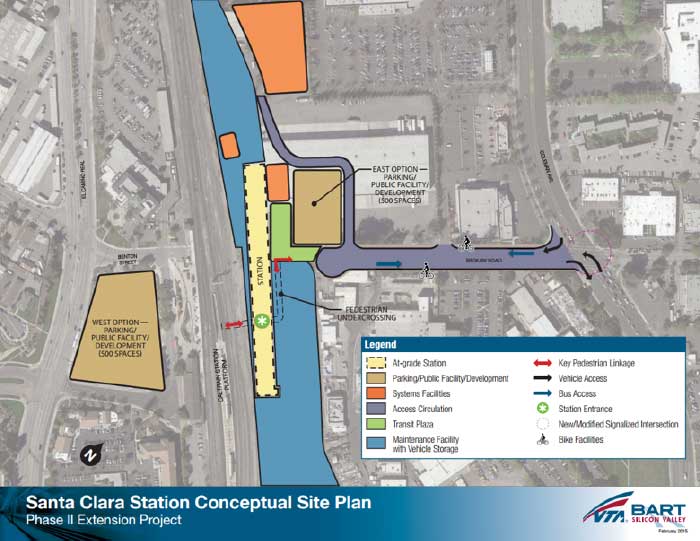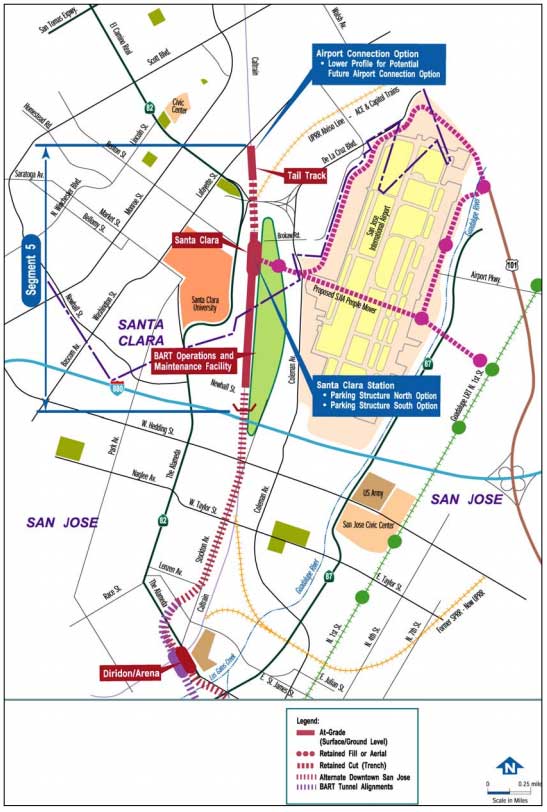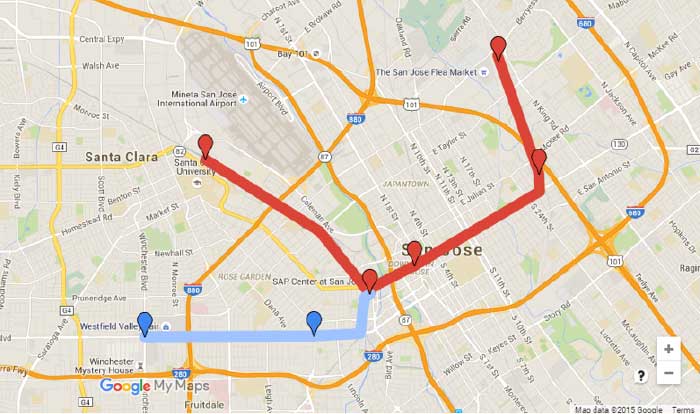After nearly two decades of planning, the timeline for completion of the Silicon Valley BART extension remains uncertain. Later this year, BART will open a five mile, $890 million extension to Warm Springs in Fremont, while the Valley Transportation Authority (VTA, working on behalf of BART) expects to open a ten mile, $2.3 billion extension to Berryessa Station in East San Jose. However, VTA remains short of funding to complete the final six mile, $4.7 billion extension to Santa Clara via Downtown San Jose and Diridon Station. In a desperate move to close this funding gap, VTA cut funding for the Santa Clara and Alum Rock stations to develop a more competitive application for federal funds. Meanwhile, VTA will seek additional money from voters for a third time this fall to close the gap.
Delaying the Santa Clara extension indefinitely may present an opportunity to take a second look at one of the Bay Area’s most redundant and wasteful transit projects. In a region desperate for new rapid transit connections, an extension of BART to Santa Clara would duplicate existing Caltrain service at a cost of several hundreds of millions of dollars without providing a convenient connection to the San Jose International Airport. As VTA hemorrhages ridership, it’s a wonder that precious resources would be expended for such little benefit.
Santa Clara was originally chosen as the terminus for BART to Silicon Valley for two reasons:
1. To provide a direct link to a proposed people mover to the San Jose International Airport
2. To provide access to a new operations and maintenance facility
On a more abstract level, BART’s loop back to Santa Clara Station would give it a foothold toward ‘ringing the Bay’ – a tired political cliche of the 1990s and early 2000s when the corridor was in planning. Given the surrounding transit-unsupportive land uses (the operations and maintenance facility, Costco, and airport-associated facilities), the station was envisioned to function mostly as a park-and-ride with 1,000 parking spaces. The existing 1,000 passengers per day for Caltrain, ACE, and Capitol Corridor service are mostly affiliated with Santa Clara University – not exactly a regional transit hub.

Unsurprisingly, a lot has changed since the Santa Clara alignment was chosen in 2004:
• Caltrain’s electrification program will expand frequency and reduce travel times by about 2020, making it more BART-like in character
• California High Speed Rail plans to serve Diridon Station by about 2025
• Planning for the automated people mover to the San Jose airport has stalled as tunneling under the airport was deemed too expensive
• Growth has shifted to the Stevens Creek Blvd corridor, including Santana Row, the new Apple Campus, and the Vallco Mall, while the transit-unsupportive land uses around Santa Clara Station have remained relatively unchanged
In 2016, therefore, a station at Santa Clara makes even less sense. Given the increasing importance of Diridon Station as a regional hub, a direct express bus connection between Diridon and the airport (along with its rental car and long-term parking facilities) would better serve riders. A single transfer to a frequent express bus service would be much faster and easier than forcing passengers to take BART to Santa Clara and transfer again to an automated people mover. Furthermore, while a maintenance facility is still necessary, VTA and BART have clearly acknowledged that they can live without such a facility temporarily by dropping it from the next project phase. It makes little sense to build two costly miles of mostly tunneled track just for a maintenance facility anyway.
There are other intriguing options. For starters, BART and VTA could stop at Diridon Station and put its savings into another more reasonable maintenance facility setup. Alternatively, Think Bigger San Jose points out that BART could reexamine the Stevens Creek Boulevard corridor given its enormous amount of planned growth. A line with stops such as Santana Row, a redeveloped Vallco Mall/Apple 2 Campus, and De Anza College would be costly and challenging, but it could also fundamentally reshape mobility in Silicon Valley. It’s not often that a project of this size would pivot that substantially, but with Santa Clara extension delayed indefinitely, VTA and BART have time to reconsider their options.
Politics, not rational planning, has always driven the BART to Silicon Valley extension. Despite its astounding $8 billion cost (including Warm Springs), BART to Silicon Valley will offer limited new connections in the polycentric geography of Silicon Valley. The redundancy and waste of Santa Clara station didn’t make sense a decade ago, and it certainly doesn’t make sense today. VTA and BART should capitalize on the delayed extension to Santa Clara as an opportunity to reevaluate alternatives that serve the needs of a growing Silicon Valley.



